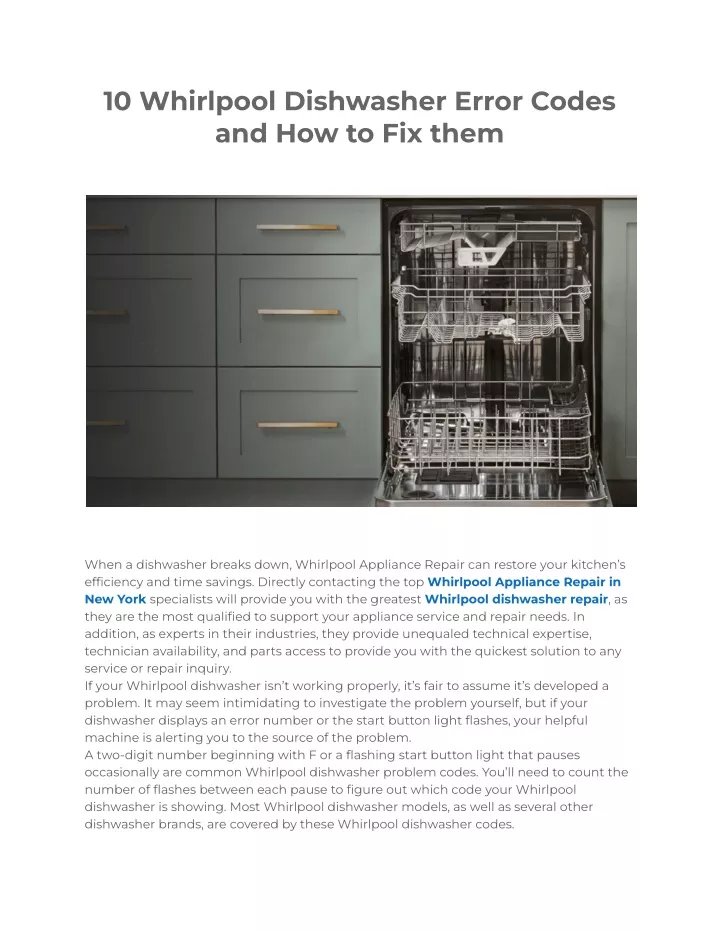
The “HE” error code specifically relates to a problem with the heating element in your dishwasher. In simple terms, this means that the dishwasher is having trouble heating the water, which is crucial for cleaning your dishes effectively. Imagine trying to wash greasy pans with cold water—it just wouldn’t do the job right! This code is your dishwasher’s way of letting you know that it’s struggling to reach the right temperature. Sometimes, it might be a minor hiccup that you can resolve on your own, but other times, it might require the expertise of a skilled technician.
Understanding the HE Error Code
To truly grasp what the HE error code entails, let’s delve a little deeper into how your Whirlpool dishwasher functions. The heating element in your dishwasher is essential for both the washing and drying processes. It ensures that the water reaches a high enough temperature to clean and sanitize your dishes properly. When the dishwasher detects an issue with heating, it displays the HE code as a cautionary signal.
Think of it like a car’s dashboard light indicating low tire pressure. It might be due to a simple reason like a drop in temperature, or it could signal something more significant like a slow leak. Similarly, the HE code could mean anything from a temporary glitch in the system to a malfunctioning heating element that needs replacement. Another thing to consider is that this error might affect how well your dishes are cleaned. You might notice residue or water spots left on your dishes, which commonly happens when the water isn’t hot enough.
If you’re not too familiar with appliance repairs, the best course of action is to start with some basic troubleshooting. Make sure your dishwasher is properly loaded, as an overfilled dishwasher can prevent proper water circulation. Check to see if there’s a reset button or a way to restart the machine, just in case it’s a one-time issue. However, if the error persists, it might be time to call in a pro.
When to Attempt DIY Fixes
You might be wondering if it’s necessary to call a technician right away or if there are some steps you can take to fix the problem yourself. Well, the answer lies in your comfort level with handling appliances and the nature of the problem. If you’re somewhat handy and have a bit of experience troubleshooting appliances, there are a few things you can try before picking up the phone.
Firstly, power off the dishwasher and unplug it. This simple reset can sometimes clear minor glitches. While it’s off, check the heating element for any visible signs of damage, like burnt spots or breaks. It’s somewhat similar to checking a light bulb: if it’s obviously broken, you know it needs replacing. However, if everything looks intact and the error still appears after restarting, it might require deeper investigation.
Inspecting the wiring and connections is another step, but this could be tricky if you’re not familiar with the appliance’s internal setup. Loose or damaged wires might prevent the heating element from functioning correctly. If you’re not confident about handling electrical components, it’s safer to seek professional help. Additionally, if you notice any burning smell or unusual noises coming from the dishwasher, stop using it immediately to avoid further damage or risk.
Signs It’s Time to Call a Technician
So, when exactly should you call a technician for your Whirlpool dishwasher’s HE error code? If the error persists after your basic troubleshooting efforts, it might be time to get some professional assistance. A technician is trained to identify and resolve issues that might not be immediately visible to the untrained eye. They can test the electrical components and replace any faulty parts like the thermostat or the heating element itself.
Another clear sign is if you experience repeated issues with the dishwasher not heating, or if it stops mid-cycle frequently. It might indicate that there’s a deeper problem with the appliance’s internal system. The technician can also ensure that all the connections are secure and that there aren’t any underlying issues that could cause further problems down the line.
Additionally, if your dishwasher is relatively new and under warranty, reaching out to a professional is advisable to avoid potentially voiding the warranty by attempting repairs yourself. Many warranties cover parts and labor for specific issues, so make sure to check your warranty details before proceeding with any DIY fixes that might complicate matters.
Maintaining Your Dishwasher to Prevent Future Issues
To avoid encountering the HE error code frequently, there are some maintenance tips you can follow. Regularly cleaning your dishwasher can go a long way. This includes cleaning the filter, checking the spray arms for clogs, and ensuring that the door seals are free from grime. It’s like keeping a car well-tuned—regular checkups can prevent bigger problems from occurring.
Routine checks can also help you spot small issues before they escalate into more significant concerns. For example, running an empty cycle with a cup of vinegar every few weeks can help clear out any mineral deposits. This simple act can enhance the dishwasher’s performance and extend its lifespan.
In conclusion, while the HE error code might signal an issue that warrants attention, it’s not always cause for immediate alarm. With a bit of investigation and troubleshooting, you can determine whether it’s a simple fix or if it’s time to call in a technician. Remember, regular maintenance is key to keeping your dishwasher running smoothly, ensuring you have sparkling clean dishes every time.